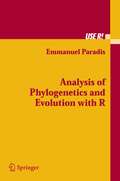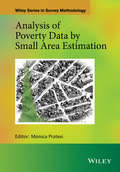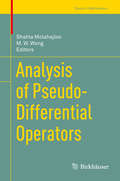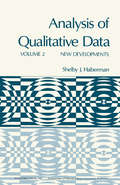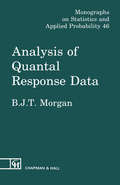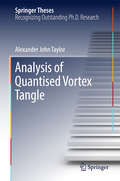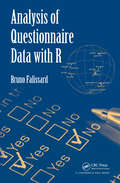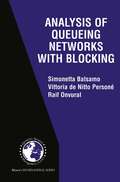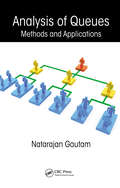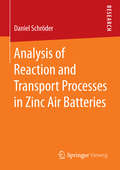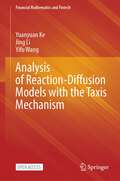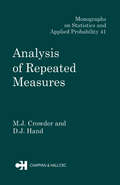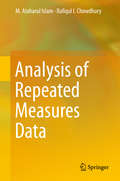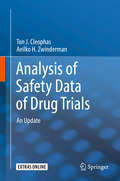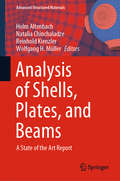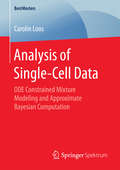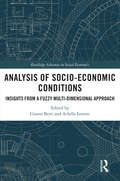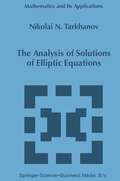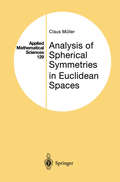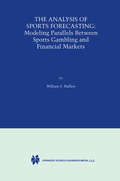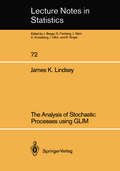- Table View
- List View
Analysis of Phylogenetics and Evolution with R (Use R!)
by Emmanuel ParadisThis book integrates a wide variety of data analysis methods into a single and flexible interface: the R language. The book starts with a presentation of different R packages and gives a short introduction to R for phylogeneticists unfamiliar with this language. The basic phylogenetic topics are covered. The chapter on tree drawing uses R's powerful graphical environment. A section deals with the analysis of diversification with phylogenies, one of the author's favorite research topics. The last chapter is devoted to the development of phylogenetic methods with R and interfaces with other languages (C and C++). Some exercises conclude these chapters.
Analysis of Poverty Data by Small Area Estimation (Wiley Series in Survey Methodology)
by Monica PratesiA comprehensive guide to implementing SAE methods for poverty studies and poverty mapping There is an increasingly urgent demand for poverty and living conditions data, in relation to local areas and/or subpopulations. Policy makers and stakeholders need indicators and maps of poverty and living conditions in order to formulate and implement policies, (re)distribute resources, and measure the effect of local policy actions. Small Area Estimation (SAE) plays a crucial role in producing statistically sound estimates for poverty mapping. This book offers a comprehensive source of information regarding the use of SAE methods adapted to these distinctive features of poverty data derived from surveys and administrative archives. The book covers the definition of poverty indicators, data collection and integration methods, the impact of sampling design, weighting and variance estimation, the issue of SAE modelling and robustness, the spatio-temporal modelling of poverty, and the SAE of the distribution function of income and inequalities. Examples of data analyses and applications are provided, and the book is supported by a website describing scripts written in SAS or R software, which accompany the majority of the presented methods. Key features: Presents a comprehensive review of SAE methods for poverty mapping Demonstrates the applications of SAE methods using real-life case studies Offers guidance on the use of routines and choice of websites from which to download them Analysis of Poverty Data by Small Area Estimation offers an introduction to advanced techniques from both a practical and a methodological perspective, and will prove an invaluable resource for researchers actively engaged in organizing, managing and conducting studies on poverty.
Analysis of Poverty Data by Small Area Estimation (Wiley Series in Survey Methodology)
by Monica PratesiA comprehensive guide to implementing SAE methods for poverty studies and poverty mapping There is an increasingly urgent demand for poverty and living conditions data, in relation to local areas and/or subpopulations. Policy makers and stakeholders need indicators and maps of poverty and living conditions in order to formulate and implement policies, (re)distribute resources, and measure the effect of local policy actions. Small Area Estimation (SAE) plays a crucial role in producing statistically sound estimates for poverty mapping. This book offers a comprehensive source of information regarding the use of SAE methods adapted to these distinctive features of poverty data derived from surveys and administrative archives. The book covers the definition of poverty indicators, data collection and integration methods, the impact of sampling design, weighting and variance estimation, the issue of SAE modelling and robustness, the spatio-temporal modelling of poverty, and the SAE of the distribution function of income and inequalities. Examples of data analyses and applications are provided, and the book is supported by a website describing scripts written in SAS or R software, which accompany the majority of the presented methods. Key features: Presents a comprehensive review of SAE methods for poverty mapping Demonstrates the applications of SAE methods using real-life case studies Offers guidance on the use of routines and choice of websites from which to download them Analysis of Poverty Data by Small Area Estimation offers an introduction to advanced techniques from both a practical and a methodological perspective, and will prove an invaluable resource for researchers actively engaged in organizing, managing and conducting studies on poverty.
Analysis of Pseudo-Differential Operators (Trends in Mathematics)
by M. W. Wong Shahla MolahajlooThis volume, like its predecessors, is based on the special session on pseudo-differential operators, one of the many special sessions at the 11th ISAAC Congress, held at Linnaeus University in Sweden on August 14-18, 2017. It includes research papers presented at the session and invited papers by experts in fields that involve pseudo-differential operators.The first four chapters focus on the functional analysis of pseudo-differential operators on a spectrum of settings from Z to Rn to compact groups. Chapters 5 and 6 discuss operators on Lie groups and manifolds with edge, while the following two chapters cover topics related to probabilities. The final chapters then address topics in differential equations.
Analysis of Quantal Response Data
by Byron J.T. MorganThis book takes the standard methods as the starting point, and then describes a wide range of relatively new approaches and procedures designed to deal with more complicated data and experiments - including much recent research in the area. Throughout mention is given to the computing requirements - facilities available in large computing packages like BMDP, SAS and SPSS are also described.
Analysis of Quantal Response Data
by Byron J.T. MorganThis book takes the standard methods as the starting point, and then describes a wide range of relatively new approaches and procedures designed to deal with more complicated data and experiments - including much recent research in the area. Throughout mention is given to the computing requirements - facilities available in large computing packages like BMDP, SAS and SPSS are also described.
Analysis of Quantised Vortex Tangle (Springer Theses)
by Alexander John TaylorIn this thesis, the author develops numerical techniques for tracking and characterising the convoluted nodal lines in three-dimensional space, analysing their geometry on the small scale, as well as their global fractality and topological complexity---including knotting---on the large scale. The work is highly visual, and illustrated with many beautiful diagrams revealing this unanticipated aspect of the physics of waves. Linear superpositions of waves create interference patterns, which means in some places they strengthen one another, while in others they completely cancel each other out. This latter phenomenon occurs on 'vortex lines' in three dimensions. In general wave superpositions modelling e.g. chaotic cavity modes, these vortex lines form dense tangles that have never been visualised on the large scale before, and cannot be analysed mathematically by any known techniques.
Analysis of Questionnaire Data with R
by Bruno FalissardWhile theoretical statistics relies primarily on mathematics and hypothetical situations, statistical practice is a translation of a question formulated by a researcher into a series of variables linked by a statistical tool. As with written material, there are almost always differences between the meaning of the original text and translated text.
Analysis of Queueing Networks with Blocking (International Series in Operations Research & Management Science #31)
by Simonetta Balsamo Vittoria de Nitto Persone Raif OnvuralQueueing network models have been widely applied as a powerful tool for modelling, performance evaluation, and prediction of discrete flow systems, such as computer systems, communication networks, production lines, and manufacturing systems. Queueing network models with finite capacity queues and blocking have been introduced and applied as even more realistic models of systems with finite capacity resources and with population constraints. In recent years, research in this field has grown rapidly. Analysis of Queueing Networks with Blocking introduces queueing network models with finite capacity and various types of blocking mechanisms. It gives a comprehensive definition of the analytical model underlying these blocking queueing networks. It surveys exact and approximate analytical solution methods and algorithms and their relevant properties. It also presents various application examples of queueing networks to model computer systems and communication networks. This book is organized in three parts. Part I introduces queueing networks with blocking and various application examples. Part II deals with exact and approximate analysis of queueing networks with blocking and the condition under which the various techniques can be applied. Part III presents a review of various properties of networks with blocking, describing several equivalence properties both between networks with and without blocking and between different blocking types. Approximate solution methods for the buffer allocation problem are presented.
Analysis of Queues (Operations Research Ser.)
by Natarajan GautamWritten with students and professors in mind, Analysis of Queues: Methods and Applications combines coverage of classical queueing theory with recent advances in studying stochastic networks. Exploring a broad range of applications, the book contains plenty of solved problems, exercises, case studies, paradoxes, and numerical examples.In addition t
Analysis of Reaction and Transport Processes in Zinc Air Batteries
by Daniel SchröderThis book contains a novel combination of experimental and model-based investigations, elucidating the complex processes inside zinc air batteries. The work presented helps to answer which battery composition and which air-composition should be adjusted to maintain stable and efficient charge/discharge cycling. In detail, electrochemical investigations and X-ray transmission tomography are applied on button cell zinc air batteries and in-house set-ups. Moreover, model-based investigations of the battery anode and the impact of relative humidity, active operation, carbon dioxide and oxygen on zinc air battery operation are presented. The techniques used in this work complement each other well and yield an unprecedented understanding of zinc air batteries. The methods applied are adaptable and can potentially be applied to gain further understanding of other metal air batteries.
Analysis of Reaction-Diffusion Models with the Taxis Mechanism (Financial Mathematics and Fintech)
by Yuanyuan Ke Jing Li Yifu WangThis open access book deals with a rich variety of taxis-type cross-diffusive equations. Particularly, it intends to show the key role played by quasi-energy inequality in the derivation of some necessary a priori estimates. This book addresses applied mathematics and all researchers interested in mathematical development of reaction-diffusion theory and its application and can be a basis for a graduate course in applied mathematics.
Analysis of Repeated Measures (Chapman And Hall/crc Monographs On Statistics And Applied Probability Ser.)
by Martin J. Crowder David J. HandRepeated measures data arise when the same characteristic is measured on each case or subject at several times or under several conditions. There is a multitude of techniques available for analysing such data and in the past this has led to some confusion. This book describes the whole spectrum of approaches, beginning with very simple and crude methods, working through intermediate techniques commonly used by consultant statisticians, and concluding with more recent and advanced methods. Those covered include multiple testing, response feature analysis, univariate analysis of variance approaches, multivariate analysis of variance approaches, regression models, two-stage line models, approaches to categorical data and techniques for analysing crossover designs. The theory is illustrated with examples, using real data brought to the authors during their work as statistical consultants.
Analysis of Repeated Measures (Chapman And Hall/crc Monographs On Statistics And Applied Probability Ser.)
by Martin J. Crowder David J. HandRepeated measures data arise when the same characteristic is measured on each case or subject at several times or under several conditions. There is a multitude of techniques available for analysing such data and in the past this has led to some confusion. This book describes the whole spectrum of approaches, beginning with very simple and crude methods, working through intermediate techniques commonly used by consultant statisticians, and concluding with more recent and advanced methods. Those covered include multiple testing, response feature analysis, univariate analysis of variance approaches, multivariate analysis of variance approaches, regression models, two-stage line models, approaches to categorical data and techniques for analysing crossover designs. The theory is illustrated with examples, using real data brought to the authors during their work as statistical consultants.
Analysis of Repeated Measures Data
by M. Ataharul Islam Rafiqul I ChowdhuryThis book presents a broad range of statistical techniques to address emerging needs in the field of repeated measures. It also provides a comprehensive overview of extensions of generalized linear models for the bivariate exponential family of distributions, which represent a new development in analysing repeated measures data. The demand for statistical models for correlated outcomes has grown rapidly recently, mainly due to presence of two types of underlying associations: associations between outcomes, and associations between explanatory variables and outcomes. The book systematically addresses key problems arising in the modelling of repeated measures data, bearing in mind those factors that play a major role in estimating the underlying relationships between covariates and outcome variables for correlated outcome data. In addition, it presents new approaches to addressing current challenges in the field of repeated measures and models based on conditional and joint probabilities. Markov models of first and higher orders are used for conditional models in addition to conditional probabilities as a function of covariates. Similarly, joint models are developed using both marginal-conditional probabilities as well as joint probabilities as a function of covariates. In addition to generalized linear models for bivariate outcomes, it highlights extended semi-parametric models for continuous failure time data and their applications in order to include models for a broader range of outcome variables that researchers encounter in various fields. The book further discusses the problem of analysing repeated measures data for failure time in the competing risk framework, which is now taking on an increasingly important role in the field of survival analysis, reliability and actuarial science. Details on how to perform the analyses are included in each chapter and supplemented with newly developed R packages and functions along with SAS codes and macro/IML. It is a valuable resource for researchers, graduate students and other users of statistical techniques for analysing repeated measures data.
Analysis of Safety Data of Drug Trials: An Update
by Ton J. Cleophas Aeilko H. ZwindermanIn 2010, the 5th edition of the textbook, "Statistics Applied to Clinical Studies", was published by Springer and since then has been widely distributed. The primary object of clinical trials of new drugs is to demonstrate efficacy rather than safety. However, a trial in humans which does not adequately address safety is unethical, while the assessment of safety variables is an important element of the trial.An effective approach is to present summaries of the prevalence of adverse effects and their 95% confidence intervals. In order to estimate the probability that the differences between treatment and control group occurred merely by chance, a statistical test can be performed. In the past few years, this pretty crude method has been supplemented and sometimes, replaced with more sophisticated and better sensitive methodologies, based on machine learning clusters and networks, and multivariate analyses. As a result, it is time that an updated version of safety data analysis was published. The issue of dependency also needs to be addressed. Adverse effects may be either dependent or independent of the main outcome. For example, an adverse effect of alpha blockers is dizziness and this occurs independently of the main outcome "alleviation of Raynaud 's phenomenon". In contrast, the adverse effect "increased calorie intake" occurs with "increased exercise", and this adverse effect is very dependent on the main outcome "weight loss". Random heterogeneities, outliers, confounders, interaction factors are common in clinical trials, and all of them can be considered as kinds of adverse effects of the dependent type. Random regressions and analyses of variance, high dimensional clusterings, partial correlations, structural equations models, Bayesian methods are helpful for their analysis. The current edition was written for non-mathematicians, particularly medical and health professionals and students. It provides examples of modern analytic methods so far largely unused in safety analysis. All of the 14 chapters have two core characteristics, First, they are intended for current usage, and they are particularly concerned with that usage. Second, they try and tell what readers need to know in order to understand and apply the methods. For that purpose, step by step analyses of both hypothesized and real data examples are provided.
Analysis of Shells, Plates, and Beams: A State of the Art Report (Advanced Structured Materials #134)
This book commemorates the 75th birthday of Prof. George Jaiani – Georgia’s leading expert on shell theory. He is also well known outside Georgia for his individual approach to shell theory research and as an organizer of meetings, conferences and schools in the field. The collection of papers presented includes articles by scientists from various countries discussing the state of the art and new trends in the theory of shells, plates, and beams. Chapter 20 is available open access under a Creative Commons Attribution 4.0 International License via link.springer.com.
Analysis of Single-Cell Data: ODE Constrained Mixture Modeling and Approximate Bayesian Computation (BestMasters)
by Carolin LoosCarolin Loos introduces two novel approaches for the analysis of single-cell data. Both approaches can be used to study cellular heterogeneity and therefore advance a holistic understanding of biological processes. The first method, ODE constrained mixture modeling, enables the identification of subpopulation structures and sources of variability in single-cell snapshot data. The second method estimates parameters of single-cell time-lapse data using approximate Bayesian computation and is able to exploit the temporal cross-correlation of the data as well as lineage information.
Analysis of Socio-Economic Conditions: Insights from a Fuzzy Multi-dimensional Approach (Routledge Advances in Social Economics)
by Gianni Betti Achille LemmiShowcasing fuzzy set theory, this book highlights the enormous potential of fuzzy logic in helping to analyse the complexity of a wide range of socio-economic patterns and behaviour. The contributions to this volume explore the most up-to-date fuzzy-set methods for the measurement of socio-economic phenomena in a multidimensional and/or dynamic perspective. Thus far, fuzzy-set theory has primarily been utilised in the social sciences in the field of poverty measurement. These chapters examine the latest work in this area, while also exploring further applications including social exclusion, the labour market, educational mismatch, sustainability, quality of life and violence against women. The authors demonstrate that real-world situations are often characterised by imprecision, uncertainty and vagueness, which cannot be properly described by the classical set theory which uses a simple true–false binary logic. By contrast, fuzzy-set theory has been shown to be a powerful tool for describing the multidimensionality and complexity of social phenomena. This book will be of significant interest to economists, statisticians and sociologists utilising quantitative methods to explore socio-economic phenomena.
Analysis of Socio-Economic Conditions: Insights from a Fuzzy Multi-dimensional Approach (Routledge Advances in Social Economics)
by Gianni Betti and Achille LemmiShowcasing fuzzy set theory, this book highlights the enormous potential of fuzzy logic in helping to analyse the complexity of a wide range of socio-economic patterns and behaviour. The contributions to this volume explore the most up-to-date fuzzy-set methods for the measurement of socio-economic phenomena in a multidimensional and/or dynamic perspective. Thus far, fuzzy-set theory has primarily been utilised in the social sciences in the field of poverty measurement. These chapters examine the latest work in this area, while also exploring further applications including social exclusion, the labour market, educational mismatch, sustainability, quality of life and violence against women. The authors demonstrate that real-world situations are often characterised by imprecision, uncertainty and vagueness, which cannot be properly described by the classical set theory which uses a simple true–false binary logic. By contrast, fuzzy-set theory has been shown to be a powerful tool for describing the multidimensionality and complexity of social phenomena. This book will be of significant interest to economists, statisticians and sociologists utilising quantitative methods to explore socio-economic phenomena.
The Analysis of Solutions of Elliptic Equations (Mathematics and Its Applications #406)
by Nikolai TarkhanovThis book is intended as a continuation of my book "Parametrix Method in the Theory of Differential Complexes" (see [291]). There, we considered complexes of differential operators between sections of vector bundles and we strived more than for details. Although there are many applications to for maximal generality overdetermined systems, such an approach left me with a certain feeling of dissat- faction, especially since a large number of interesting consequences can be obtained without a great effort. The present book is conceived as an attempt to shed some light on these new applications. We consider, as a rule, differential operators having a simple structure on open subsets of Rn. Currently, this area is not being investigated very actively, possibly because it is already very highly developed actively (cf. for example the book of Palamodov [213]). However, even in this (well studied) situation the general ideas from [291] allow us to obtain new results in the qualitative theory of differential equations and frequently in definitive form. The greater part of the material presented is related to applications of the L- rent series for a solution of a system of differential equations, which is a convenient way of writing the Green formula. The culminating application is an analog of the theorem of Vitushkin [303] for uniform and mean approximation by solutions of an elliptic system. Somewhat afield are several questions on ill-posedness, but the parametrix method enables us to obtain here a series of hitherto unknown facts.
Analysis of Spherical Symmetries in Euclidean Spaces (Applied Mathematical Sciences #129)
by Claus MüllerThis self-contained book offers a new and direct approach to the theories of special functions with emphasis on spherical symmetry in Euclidean spaces of arbitrary dimensions. Based on many years of lecturing to mathematicians, physicists and engineers in scientific research institutions in Europe and the USA, the author uses elementary concepts to present the spherical harmonics in a theory of invariants of the orthogonal group. One of the highlights is the extension of the classical results of the spherical harmonics into the complex - particularly important for the complexification of the Funk-Hecke formula which successfully leads to new integrals for Bessel- and Hankel functions with many applications of Fourier integrals and Radon transforms. Numerous exercises stimulate mathematical ingenuity and bridge the gap between well-known elementary results and their appearance in the new formations.
The Analysis of Sports Forecasting: Modeling Parallels between Sports Gambling and Financial Markets
by William S. MalliosGiven the magnitude of currency speculation and sports gambling, it is surprising that the literature contains mostly negative forecasting results. Majority opinion still holds that short term fluctuations in financial markets follow random walk. In this non-random walk through financial and sports gambling markets, parallels are drawn between modeling short term currency movements and modeling outcomes of athletic encounters. The forecasting concepts and methodologies are identical; only the variables change names. If, in fact, these markets are driven by mechanisms of non-random walk, there must be some explanation for the negative forecasting results. The Analysis of Sports Forecasting: Modeling Parallels Between Sports Gambling and Financial Markets examines this issue.
The Analysis of Stochastic Processes using GLIM (Lecture Notes in Statistics #72)
by James K. LindseyThe aim of this book is to present a survey of the many ways in which the statistical package GLIM may be used to model and analyze stochastic processes. Its emphasis is on using GLIM interactively to apply statistical techniques, and examples are drawn from a wide range of applications including medicine, biology, and the social sciences. It is based on the author's many years of teaching courses along these lines to both undergraduate and graduate students. The author assumes that readers have a reasonably strong background in statistics such as might be gained from undergraduate courses and that they are also familiar with the basic workings of GLIM. Topics covered include: the analysis of survival data, regression and fitting distributions, time series analysis (including both the time and frequency domains), repeated measurements, and generalized linear models.
